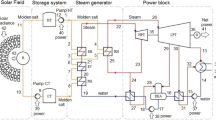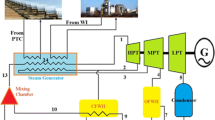Abstract
Exergoeconomic is the combination of exergy analysis and cost estimation based on exergy values at each state. Application of exergoeconomic in multi-generation systems mainly aims at designing more sustainable units in terms of waste handling by considering cost and the source of irreversibility. Unlike many other cost methods applied to multi-generation system, manipulating the overall cost of a complex system in exergoeconomic analysis by defining a unit overall product cost with the influence of each product cost separately is fully straightforward. Due to this and many other merits of exergoeconomic in cost estimation of multi-generation systems, exergoeconomic analysis of the devised solar tower-based multi-generation system in the previous chapter is carried out in here. To attain this goal, exergy analysis of the reckoned setup is performed. Results of exergy analysis indicated that the receiver has a pivotal role in the overall exergy destruction by exergy destruction of 2006 kW, followed by heliostat by 1867 kW. The overall exergy efficiency and cost of the system are computed 21.45% and 743.2 $/h, respectively. At last, an extensive parametric study is presented to demonstrate altering trend of the chief performance criteria around the base input data. It was discerned that exergy efficiency can even be raised up from the base value with the rise of direct normal irradiance (DNI), receiver concentration ratio, and heat exchangers effectiveness or with the decrease of the generator pinch point temperature, ambient temperature, and amount of electricity supplied to the transcritical CO2 refrigeration cycle. In terms of cost, the overall cost rate parameter can be decreased by decreasing the amount of electricity supplied to the transcritical CO2 refrigeration cycle, heat exchangers effectiveness, generator pinch point temperature, DNI, and receiver concentration ratio.
Access this chapter
Tax calculation will be finalised at checkout
Purchases are for personal use only
Similar content being viewed by others
Abbreviations
- C:
-
Concentration ratio
- h:
-
Enthalpy (kJ. kg−1), convection coefficient (W/m2K)
- K:
-
Conductivity (W/m.K)
- L:
-
Length of tube (m)
- S:
-
Supercritical
- T:
-
Temperature (K), transcritical
- V:
-
Wind velocity (m/s)
- X:
-
Salinity (g. kg−1)
- Fr:
-
View factor
- HTR:
-
High-temperature recuperator
- HU:
-
Heating unit
- LTR:
-
Low-temperature recuperator
- MC:
-
Main compressor
- MFR:
-
Mass flow ratio
- PPTD:
-
Pinch point temperature difference (K)
- RC:
-
Recompression compressor
- STP:
-
Solar tower power
- δ:
-
Thickness (m)
- ε:
-
Effectiveness, emissivity
- η:
-
Efficiency (%)
- λ:
-
Conductivity (W/m.K)
- μ:
-
Viscosity (Pa.s)
- ω:
-
Humidity
- ρ:
-
Reflectivity, density (kg/m3)
- Ape:
-
Aperture
- em:
-
Emissive
- Dhum:
-
Dehumidifier
- fc:
-
Forced convection
- Gen:
-
Generator
- Hum:
-
Humidifier
- H, Hel:
-
Heliostat
- Insi:
-
Inner side of receiver
- Insu:
-
Insulation
- is:
-
Isentropic
- ms:
-
Molten salt
- nc:
-
Natural convection
- ref:
-
Reflection
- Sur:
-
Surface
- sw:
-
Sea water
- TC:
-
Transcritical compressor
- W:
-
Wall
References
Bejan, A., & Tsatsaronis, G. (1996). Thermal design and optimization. John Wiley & Sons, USA.
Bejan, A. (2016). Advanced engineering thermodynamics. John Wiley & Sons, USA.
Tsatsaronis, G. (1993). Thermoeconomic analysis and optimization of energy systems. Progress in Energy and Combustion Science, 19(3), 227–257.
Leiva-Illanes, R., et al. (2019). Exergy cost assessment of CSP driven multi-generation schemes: Integrating seawater desalination, refrigeration, and process heat plants. Energy Conversion and Management, 179, 249–269.
Ma, Y., et al. (2019). Optimal integration of recompression supercritical CO2 Brayton cycle with main compression intercooling in solar power tower system based on exergoeconomic approach. Applied Energy, 242, 1134–1154.
Nayar, K. G., Sharqawy, M. H., & Banchik, L. D. (2016). Thermophysical properties of seawater: A review and new correlations that include pressure dependence. Desalination, 390, 1–24.
Sharqawy, M. H., Lienhard, J. H., & Zubair, S. M. (2010). Thermophysical properties of seawater: A review of existing correlations and data. Desalination and Water Treatment, 16(1–3), 354–380.
Wepfer, W., Gaggioli, R., & Obert, E. (1979). Proper evaluation of available energy for HVAC. ASHRAE Transactions, 85(1), 214–230.
CEPCI. (2016). Chemical engineering plant cost index. Chemical Engineer. www.chemengonline.com.
Nathan, G., Battye, D., & Ashman, P. (2014). Economic evaluation of a novel fuel-saver hybrid combining a solar receiver with a combustor for a solar power tower. Applied Energy, 113, 1235–1243.
Ipakchi, O., Mosaffa, A., & Farshi, L. G. (2019). Ejector based CO2 transcritical combined cooling and power system utilizing waste heat recovery: A thermoeconomic assessment. Energy Conversion and Management, 186, 462–472.
Rostamzadeh, H., et al. (2018). Exergoeconomic optimisation of basic and regenerative triple-evaporator combined power and refrigeration cycles. International Journal of Exergy, 26(1–2), 186–225.
Sayyaadi, H., & Ghorbani, G. (2018). Conceptual design and optimization of a small-scale dual power-desalination system based on the Stirling prime-mover. Applied Energy, 223, 457–471.
Gholizadeh, T., Vajdi, M., & Mohammadkhani, F. (2019). Thermodynamic and thermoeconomic analysis of basic and modified power generation systems fueled by biogas. Energy Conversion and Management, 181, 463–475.
Kotas, T. J. (2013). The exergy method of thermal plant analysis. John Wiley & Sons, USA.
Wang, X., & Dai, Y. (2016). Exergoeconomic analysis of utilizing the transcritical CO2 cycle and the ORC for a recompression supercritical CO2 cycle waste heat recovery: A comparative study. Applied Energy, 170, 193–207.
Author information
Authors and Affiliations
Editor information
Editors and Affiliations
Rights and permissions
Copyright information
© 2020 Springer Nature Switzerland AG
About this chapter
Cite this chapter
Ghiasirad, H., Rostamzadeh, H., Nasri, S. (2020). Design and Evaluation of a New Solar Tower-Based Multi-generation System: Part II, Exergy and Exergoeconomic Modeling. In: Jabari, F., Mohammadi-Ivatloo, B., Mohammadpourfard, M. (eds) Integration of Clean and Sustainable Energy Resources and Storage in Multi-Generation Systems. Springer, Cham. https://doi.org/10.1007/978-3-030-42420-6_6
Download citation
DOI: https://doi.org/10.1007/978-3-030-42420-6_6
Published:
Publisher Name: Springer, Cham
Print ISBN: 978-3-030-42419-0
Online ISBN: 978-3-030-42420-6
eBook Packages: EnergyEnergy (R0)




